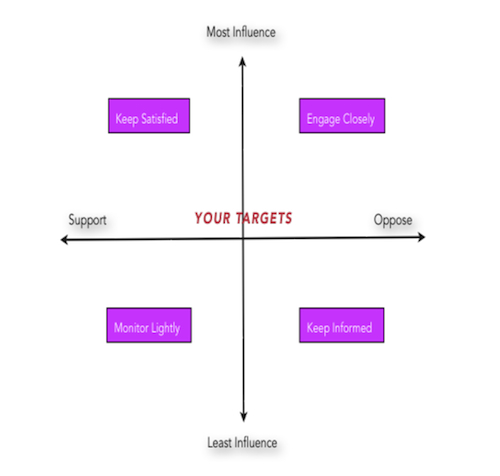Most B2B companies know that social media is a great tool for not only increasing awareness and engagement, but also generating high-value customer referrals. If you didn’t already know this, then keep in mind that the closing ratio for nonreferred leads is only 10 percent versus a 60 percent closing ratio for referred leads.
The big question is this: How can businesses figure out which customers are most likely to refer their brand to others? Or to put it another way: How can a business target the most powerful brand ambassadors?
There are a number of online tools to help a company find its potential influencers (individuals with the power to affect the purchasing decisions of others). But first it’s important to step back and view the brand on an aggregate level. Enter the power map:

Before we dive into it, let’s take a look at some definitions to help you better understand the goals and objectives of this planning exercise.
On the Y-axis of the power map is a gradient of influence. Influence refers to whose commentary has the greatest reach in the social media world. For example, a customer with a large Twitter following (say 1,000+ followers) will reach a massive network of people with just one tweet about your brand. Therefore, customers who belong in the top half (or Most Influence section) of the power map will likely be your most effective brand ambassadors, if you can engage them effectively.
On opposite ends of the power map’s X-axis are Support and Oppose. Use these terms to help you measure the likelihood that a fan will promote your brand. Doing this should give you a feel for how you can best direct your company’s resources. For instance, if you’re a small company that’s selling an app for online subscription billing to e-commerce companies, then a large company with a similar product, such as American Express, may not be the best one to target. Keep in mind, this doesn’t mean American Express is opposed to your brand, but they won’t be very receptive when it comes to actively following and engaging with your social media marketing programs.
The power map example above also includes four boxes to help you understand how aggressively you should pursue each group of fans (Most Influence/Supportive; Most Influence/Opposed; Least Influence/Supportive; Least Influence/Opposed). An extremely influential fan who already supports your brand is a clear win. There’s not much to do here other than maintain an already rosy relationship. But on the opposite side of the map, a highly influential company that “opposes” your brand may be a good target to work to convert into a new powerful brand ambassador. Of course, this all depends on the type of business you’re running and the types of fans you’re looking to bring onboard.
Power mapping is an effective way to identify and leverage key influencers for your company’s social media goals. However, it’s also an offline visual tool. So it would be a good idea to map this out on a whiteboard. (Crazy, I know.) But before you put dry erase marker to board, there are a few steps you should take first.
Brainstorm. Start by brainstorming a list of keywords, buzzwords, and competitors’ names—anything relevant to discovering which brands and customers make up your niche market. From here you can determine the ideal person or customer you want to influence. This is a good starting point, as your current customer base can best influence your overall engagement strategy, and it should also provide a good baseline moving forward.
Link them. Next, you’ll want to link your customer baseline to other people or institutions that may have a strong impact. Do you have an influential fan who is also a strong supporter of your brand? Look at the types of followers/fans this person or company has. It’s likely that these potential customers are just one step away from making a purchase—if you can compel your biggest influencer to refer them to you.
Leave no stone unturned. The keys to creating a successful power map are being creative, strategic, and thorough. You never know who might make a difference when pursuing your overall brand objectives.
Keeping this power map in mind, you can move forward by discovering where your target ambassadors hang out, what they’re saying, and with whom they’re interacting. Then you’ll be ready to put together a more effective social media strategy for looping in new referrals and sales. When it comes to finding your most influential fans, the power is in your hands.
Have you tried power mapping? Is it part of your referral marketing program?

